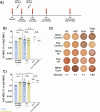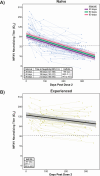The two-dose MVA-BN mpox vaccine induces a nondurable and low avidity MPXV-specific antibody response
- PMID: 40162783
- PMCID: PMC12456018
- DOI: 10.1128/jvi.00253-25
The two-dose MVA-BN mpox vaccine induces a nondurable and low avidity MPXV-specific antibody response
Erratum in
-
Correction for Oom et al., "The two-dose MVA-BN mpox vaccine induces a nondurable and low avidity MPXV-specific antibody response".J Virol. 2025 Sep 23;99(9):e0087225. doi: 10.1128/jvi.00872-25. Epub 2025 Sep 4. J Virol. 2025. PMID: 40905658 Free PMC article. No abstract available.
Abstract
The 2022 global outbreak of clade IIb mpox was the first major outbreak of mpox outside of African nations. To control the outbreak, public health officials began vaccination campaigns using the third-generation orthopoxvirus vaccine modified vaccinia Ankara from Bavarian Nordic (MVA-BN). Prior to this outbreak, the durability of monkeypox virus (MPXV)-specific immunity induced by MVA-BN was poorly understood. In 2022, we launched the New York City Observational Study of Mpox Immunity (NYC OSMI, NCT05654883), a longitudinal study of 171 participants comprising MVA-BN vaccines and mpox convalescent individuals. Peripheral blood sampling was performed at intervals including prior to vaccination, after one dose, and after the second dose. MVA-BN vaccinees with and without a history of smallpox vaccination demonstrated detectable MPXV-specific memory B cells at 1-year post-vaccination. Additionally, MVA-BN increased MPXV neutralizing titers in smallpox vaccine-naïve vaccinees, with a comparable maximum titer reached in naïve and smallpox vaccine-experienced vaccinees. However, neutralizing titers returned to baseline within 5-7 months for naïve individuals, while remaining elevated in those with prior smallpox vaccination. Both naïve and experienced individuals generated robust IgG responses against MPXV H3 and A35, but naïve vaccinees' IgG responses showed lower avidity than experienced vaccinees. These data highlight a low avidity antibody response elicited by MVA-BN that is short-lived in naïve vaccinees. This work supports the need for long-term studies on protection induced by MVA-BN, including the potential need for booster doses as well as the development of next-generation orthopoxvirus vaccines.
Importance: The ongoing outbreaks of mpox demonstrate the continuing threat of orthopoxviruses to global health. While previous orthopoxvirus vaccines generated lifelong antibody and cellular immunity, we show here that the current mpox vaccine, MVA-BN or JYNNEOS, fails to induce durable antibody immunity in individuals with no prior smallpox vaccination. This raises the important question of whether MVA-BN vaccinees have long-term protection from mpox. Our work highlights the need for further studies into the durability of protection generated by MVA-BN as well as whether subsequent booster doses are necessary to maintain protection.
Keywords: JYNNEOS; MPXV; MVA-BN; antibody response; mpox; orthopoxviruses; vaccination.
Conflict of interest statement
M.J.M. reports the following potential competing interests: laboratory research and clinical trials contracts for vaccines or MAB with Lilly, Pfizer, and Sanofi; research grant funding from USG/HHS/NIH for vaccine and MAB clinical trials; and personal fees for Scientific Advisory Board service from Hillevax, Merck, Meissa Vaccines, Sanofi, and Pfizer.
Figures






References
-
- 2022-23 Mpox (Monkeypox) outbreak: global trends. 2023. Available from: https://worldhealthorg.shinyapps.io/mpx_global
-
- Outbreak cases and data | Mpox | poxvirus | CDC. 2022. Available from: https://www.cdc.gov/poxvirus/mpox/response/2022/index.html
Publication types
MeSH terms
Substances
Grants and funding
LinkOut - more resources
Full Text Sources
Medical

